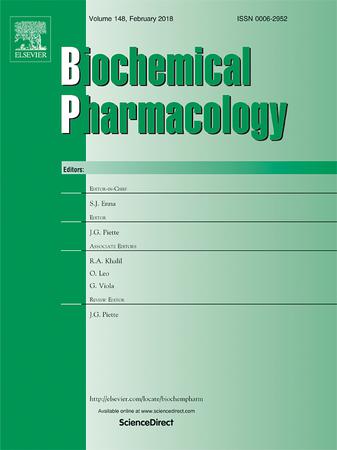WISP3通过TGF-β信号通路上调SDCBP表达,促进非小细胞肺癌的进展
IF 5.6
2区 医学
Q1 PHARMACOLOGY & PHARMACY
引用次数: 0
摘要
非小细胞肺癌(NSCLC)占肺癌病例的85%,构成了主要的健康负担。我们之前的研究表明,纤维连接蛋白通过上调Wnt诱导的信号通路蛋白3 (WISP3)和激活Wnt信号传导来促进NSCLC血管生成和进展。本研究旨在探讨WISP3在NSCLC进展中的作用及其机制。用重组质粒转染细胞,研究基因过表达/沉默效应。进行功能检测,包括管形成、球形成、免疫组织化学、western blotting、Transwell和MTT。采用质谱和生物信息学分析鉴定非小细胞肺癌细胞中差异表达蛋白及其相关信号通路。建立非小细胞肺癌异种移植瘤模型。WISP3在非小细胞肺癌中的高表达与预后不良相关,因为它增强了非小细胞肺癌细胞的血管生成和致瘤潜能,我们构建的异种移植肿瘤实验进一步证实了这一点。在机制上,以p-smad2/3激活为表征的TGF-β信号通路的激活与WISP3促进NSCLC的进展有关。此外,WISP3的过表达导致体外和体内syntenin binding protein (SDCBP)表达增加,而WISP3与SDCBP的结合增强了NSCLC的血管生成和致瘤潜能,这可以通过沉默SDCBP来抵消,表明它们在NSCLC进展中的重要作用。我们对WISP3在促进NSCLC进展中的作用提供了新的见解,表明它上调SDCBP并参与TGF-β信号传导。这些发现有助于更好地了解非小细胞肺癌生物学,并提出了该疾病的潜在治疗靶点。本文章由计算机程序翻译,如有差异,请以英文原文为准。

WISP3 upregulates SDCBP expression to promote the progression of non-small cell lung cancer via the TGF-β signaling pathway
Non-small cell lung cancer (NSCLC) accounts for 85% of lung cancer cases, posing a major health burden. Our prior work indicated fibronectin promotes NSCLC angiogenesis and progression by upregulating Wnt-inducible signaling pathway protein 3 (WISP3) and activating Wnt signaling. This study aims to explore WISP3′s role and mechanisms in NSCLC progression. Cells were transfected with a reconstructed plasmid to study gene overexpression/silencing effects. Functional assays were conducted, including tube formation, sphere formation, immunohistochemistry, western blotting, Transwell, and MTT. Mass spectrometry and bioinformatics analysis were used to identify differentially expressed proteins and their associated signaling pathways in NSCLC cells. Additionally, the xenograft tumor model of NSCLC was constructed. High expression of WISP3 in NSCLC is associated with poor prognosis, as it enhances angiogenic and tumorigenic potential in NSCLC cells, further verified in our constructed xenograft tumor experiment. In terms of mechanisms, the activation of the TGF-β signaling pathway, indicated by p-smad2/3 activation, is implicated in the progression of NSCLC promoted by WISP3. Additionally, overexpression of WISP3 leads to increased syntenin binding protein (SDCBP) expression in vitro and in vivo, and WISP3 binding to SDCBP enhances angiogenic and tumorigenic potential in NSCLC, which can be counteracted by silencing SDCBP, indicating their crucial role in NSCLC progression. We offer new insights into WISP3′s role in promoting NSCLC progression, showing it upregulates SDCBP and is involved in TGF-β signaling. The findings contribute to a better understanding of NSCLC biology and suggest potential therapeutic targets for the disease.
求助全文
通过发布文献求助,成功后即可免费获取论文全文。
去求助
来源期刊

Biochemical pharmacology
医学-药学
CiteScore
10.30
自引率
1.70%
发文量
420
审稿时长
17 days
期刊介绍:
Biochemical Pharmacology publishes original research findings, Commentaries and review articles related to the elucidation of cellular and tissue function(s) at the biochemical and molecular levels, the modification of cellular phenotype(s) by genetic, transcriptional/translational or drug/compound-induced modifications, as well as the pharmacodynamics and pharmacokinetics of xenobiotics and drugs, the latter including both small molecules and biologics.
The journal''s target audience includes scientists engaged in the identification and study of the mechanisms of action of xenobiotics, biologics and drugs and in the drug discovery and development process.
All areas of cellular biology and cellular, tissue/organ and whole animal pharmacology fall within the scope of the journal. Drug classes covered include anti-infectives, anti-inflammatory agents, chemotherapeutics, cardiovascular, endocrinological, immunological, metabolic, neurological and psychiatric drugs, as well as research on drug metabolism and kinetics. While medicinal chemistry is a topic of complimentary interest, manuscripts in this area must contain sufficient biological data to characterize pharmacologically the compounds reported. Submissions describing work focused predominately on chemical synthesis and molecular modeling will not be considered for review.
While particular emphasis is placed on reporting the results of molecular and biochemical studies, research involving the use of tissue and animal models of human pathophysiology and toxicology is of interest to the extent that it helps define drug mechanisms of action, safety and efficacy.
 求助内容:
求助内容: 应助结果提醒方式:
应助结果提醒方式:


